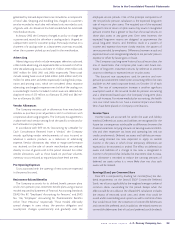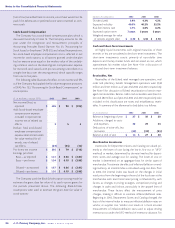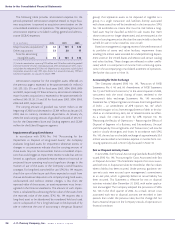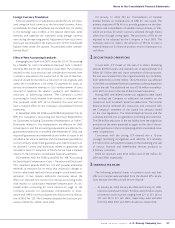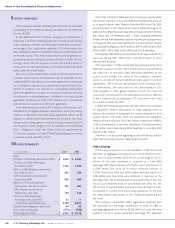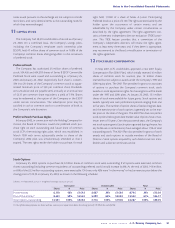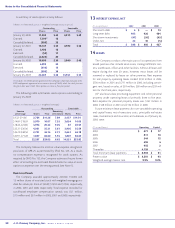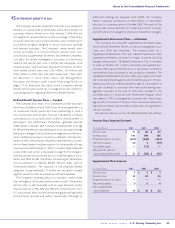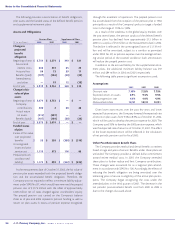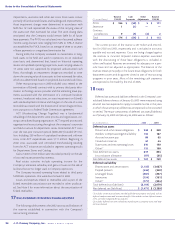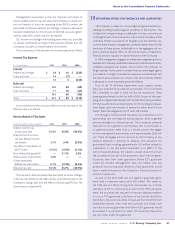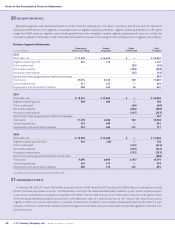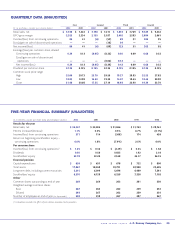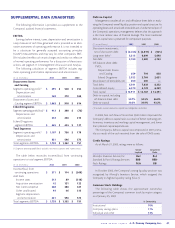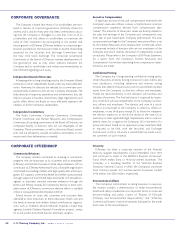JCPenney 2002 Annual Report Download - page 36
Download and view the complete annual report
Please find page 36 of the 2002 JCPenney annual report below. You can navigate through the pages in the report by either clicking on the pages listed below, or by using the keyword search tool below to find specific information within the annual report.
2002 annual report J. C. Penney Company, Inc. 33
Notes to the Consolidated Financial Statements
15 RETIREMENT BENEFIT PLANS
The Company provides retirement and other post-retirement
benefits to substantially all employees (associates), except for
associates hired or rehired on or after January 1, 2002 who are
not eligible for retiree medical or dental coverage. These bene-
fits are an important part of the Company’s total compensation
and benefits program designed to attract and retain qualified
and talented associates. The Company’s retiree benefit plans
consist principally of a non-contributory pension plan, non-
contributory supplemental retirement and deferred compensa-
tion plans for certain management associates, a contributory
medical and dental plan, and a 401(k) and employee stock
ownership plan. Total Company expense/(income) for all retire-
ment-related benefit plans was $139 million, $34 million and
$(35) million in 2002, 2001 and 2000, respectively. These plans
are described in more detail below. See Management’s
Discussion and Analysis under Critical Accounting Policies on
pages 5-7 for additional discussion of the Company’s defined
benefit pension plan and Note 1 on page 23 for the Company’s
accounting policies regarding retirement-related benefits.
Defined Benefit Pension Plans — Funded
The Company and certain of its subsidiaries provide associates
who have completed at least 1,000 hours of service generally in a
12 consecutive month period and have attained age 21 with a
non-contributory pension plan. The plan is funded by Company
contributions to a trust fund, which is held for the sole benefit of
participants and beneficiaries. Participants generally become
100% vested in the plan after five years of employment or at age
65. Pension benefits are calculated based on an associate’s average
final pay, an average of the social security wage base, and the asso-
ciate’s credited service (up to 35 years), as defined in the plan doc-
ument. In 2001, the Company adopted an amendment to its pen-
sion to freeze benefits and participation for substantially all drug-
store associates effective July 31, 2001. In its place, Eckerd adopted
a new 401(k) plan which is discussed on page 35. The change in
the pension plan was accounted for as a curtailment gain in accor-
dance with SFAS No. 88, “Employers’ Accounting for Settlements
and Curtailments of Defined Benefit Pension Plans and for
Termination Benefits.” The reduction in the projected benefit
obligation of approximately $11 million was recorded in Eckerd
segment results for 2001 as a reduction of SG&A expenses.
The Company’s funding policy is to maintain a well funded
plan throughout all business and economic cycles. The primary
pension plan is well diversified with an asset allocation policy
that provides for a 70%, 20% and 10% mix of equities (U.S., non-
U.S. and private), fixed income (investment grade and high yield)
and real estate (private and public), respectively. Although no
additional funding was required under ERISA, the Company
made a voluntary contribution of $300 million, or $190 million
after tax, to its pension plan in October 2002. The assets of the
pension plan consist primarily of a balanced portfolio of equity
and debt securities managed by third party investment managers.
Supplemental Retirement Plans — Unfunded
The Company has unfunded supplemental retirement plans,
which provide retirement benefits to certain management asso-
ciates and other key employees. The primary plans are a
Supplemental Retirement Plan and a Benefit Restoration Plan.
Supplemental benefits are based on length of service and final
average compensation. The Benefit Restoration Plan is intended
to make up benefits that could not be paid by the qualified pen-
sion plan due to governmental limits on the amount of benefits
and the level of pay considered in the calculation of benefits. The
Supplemental Retirement Plan also offers participants who leave
the Company between ages 60 and 62 benefits equal to the esti-
mated social security benefits payable at age 62. Participation in
this plan is limited to associates who were profit-sharing man-
agement associates at the end of 1995. Also included in the
unfunded plans is a Voluntary Early Retirement Program, which
was offered in 1997 to management associates who were at least
age 55 with a minimum of 10 years of service and who elected to
take early retirement. Several other smaller plans and agreements
are also included.
Net periodic pension cost for the defined benefit plans follows:
Pension Plans Expense/(Income)
($ in millions) 2002 2001 2000
Service costs $71$82$92
Interest costs 193 189 186
Projected return on assets (283) (348) (354)
Net amortization 40 3 (19)
Curtailment gain —(11) —
Net periodic pension
plans expense/(income) $21$ (85) $ (95)
Supplemental Plans Expense
($ in millions) 2002 2001 2000
Service costs $3$3$3
Interest costs 22 22 23
Projected return on assets ———
Net amortization 956
Net supplemental
plans expense $34$30$32


